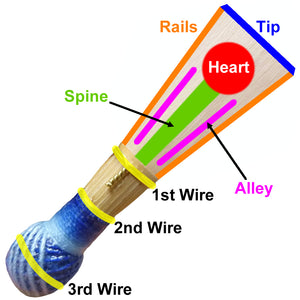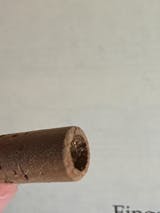Diagnosing Your Bassoon Reeds
Before being able to adjust your bassoon reeds you must first decide what is wrong with the reed, it is no use simply saying the reed is 'bad'. Some issues you may find with reeds can include: finding it hard to tongue fast, low or you may find high register is hard to play, the reed is too 'dark', the reed can't play soft enough, it has a sharp low register, etc. You then need to try and solve these issues one at a time!
Names of the Areas of a Bassoon Reed

Balance
The main efforts of a reed maker go into 'balancing' the reed. Balancing the reed means that the reed is symmetrical on either side of the spine and on both sides of the blade, this allows the reed to vibrate at its best. The important point to take away from this is that if you scrape one area of the bassoon reed you must scrape that area on the other side of the spine and on the other side of the reed blade. However, if one area looks thicker than the same area on the other side of the reed blade you need to made them the same by taking some cane off from the thicker area.
For more info about balancing bassoon reeds visit our *NEW* Bassoon Reed Balancing Guide!
Before any adjusting soak the reed for a minute or so to avoid the reed splitting.
Adjusting the Reed's Wires
Adjusting the bassoon reed's wires is the first place to look as any changes can be reversed if they don't work that well! For these adjustments you will need a small pair of pliers and the bassoon mandrel. Place the reed on the mandrel to provide support and stability and then use the pliers, pressing gently, in the following manners:
The 1st Wire
This wire should, as a starting point be loose enough that you can see it move slightly when you press your finger nail against it but not so loose that you can easily move the wire up and down the reed shaft.
Loosening the wire will:
- Allow the reed to vibrate more
- Create a lower tone in the reeds 'crow'
Tightening the wire will:
- Dampen the reeds vibrations
- Create a higher tone in the reeds 'crow'
Making the wire rounder by squeezing the sides of the reed, where the wire is, will:
- Open the tip of the reed
- Makes the reed flatter in pitch
- Makes the reed more resistant
Making the wire more oval by squeezing the top & bottom of the reed, where the wire is, will:
- Close the tip of the reed
- Makes the reed sharper in pitch
- Makes the reed more responsive
The 2nd Wire
This wire should be tight so that it cannot be moved.
Tightening the wire will:
- Increase the pitch stability of the reed
Making the wire rounder by squeezing the sides of the reed, where the wire is, will:
- Close the tip of the reed
- Make high notes stronger
- Make the reed sharper in pitch
- Mellows the sound of the reed
- Improves stability of E and C# (below middle C) .
- Makes the reed more resistant
Making the wire more oval by squeezing the top & bottom of the reed, where the wire is, will:
- Open the tip of the reed
- Make the reed flatter in pitch
- Increase response & freeness of the reed
- Creates a brighter sound
- Increases projection
- Makes low notes stronger
The 3rd Wire
Never touch this when adjusting reeds (in most cases you can't see this wire as it is under the thread wrapping at the bottom of the reed).
Scraping Bassoon Reeds
Learning how to scrape bassoon reeds can be a long process as much of how you learn will be based on trial & error. You can either use a file or a knife which must be kept very sharp using a sharpening stone for scraping the reed. When scraping the reed insert a bassoon plaque to support the reed and your knife / file. When scraping bassoon reeds only take a minute amount of cane off at a time and then try playing the reed before doing more editing. This is important as once you have scraped the reed you cannot reverse what you have done!
Below are some very generalized areas of the reed in which you can scrape to hopefully achieve the desired effect. The following points are very generalized as each reed is very different to the one before due to factors including the density of cane, when the cane was picked, direction of the grain, etc... and so how you scrape each reed and how it reacts will vary.


Generalized Effects After Scraping this Area:
A: Freer & flatter low register
B: Softer reed
C: Flatter low register
D: Easier tonguing & easier ppp in high register
E: Less resistant low register & overall flatter
F: More freedom & flexibility BUT weaker "sound" & stability
G: Makes sound brighter, more flexibility & easier tonguing
Tips
- When played loudly the reed doesn't play E or C# in the stave in tune. The E and / or C# dip flatter. After making sure the reed is balanced (see above) and the 2nd wire is tight clip off a very, very small amount of the tip of the reed off at a time. Then try the reed playing those two notes very loudly, continuing to clip until you no longer have a flat & unstable E.
This guide is not meant to be a strict guide in which you follow every point exactly, it merely provides a starting point and some guidance to help you learn where & how to adjust bassoon reeds. So, have fun and experiment!
If you have any thoughts about this guide please let us know at matthew@crookandstaple.com
|
|
Bassoonist at Crook and Staple |


